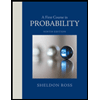
A First Course in Probability (10th Edition)
10th Edition
ISBN: 9780134753119
Author: Sheldon Ross
Publisher: PEARSON
expand_more
expand_more
format_list_bulleted
Question
Help please:
Consider two continuous random variables Y and Z, and a random variable X that is equal to Y
with
terms of the PDF of Y and Z.
Expert Solution
This question has been solved!
Explore an expertly crafted, step-by-step solution for a thorough understanding of key concepts.
This is a popular solution
Trending nowThis is a popular solution!
Step by stepSolved in 3 steps

Knowledge Booster
Similar questions
- Please fast answer and correct answerarrow_forwardLet a,b,c and d be constants. Use the rules of expected value to show that Cov(aX+b, cY+d) = ac Cov(X,Y).arrow_forwardDelores must grade a driver’s test completed by a group of training students. She knows that driver’s test scores are normally distributed with µ = 50 and σ = 6. Students are required to score in the top 75% of students on the test in order to pass the test and continue on with the training course. Which score do students need to obtain at a minimum in order to pass the test and continue with the course? a. X = 54 b. X = 60 c. X = 46 d. X = 40arrow_forward
- show workarrow_forwardThe first four central moments of a distribution are 0, 16, -36 and 120 respectively. Comment upon the Skewness and Kurtosis of the distribution.arrow_forwardThe flight from Greenville to Charlotte can take anywhere from 43 minutes to 68 minutes. Suppose the random flying times, X, are uniform from 43 to 68 minutes. On average, how long does it take to fly from Greenville to Charlotte? μX=μX= Do not round.arrow_forward
- You are given the probability distribution function (PDF) of a continuous random variable X is fX(x). Let Y be a continuous random variable such that Y = aX + b, where a and b are non-zero real constants.1. Find the PDF of Y in terms of fX , a, and b.2. Let X be an exponential random variable with parameter λ. When will Yalso be an exponential random variable? 3. Let X be a normal random variable with mean μ and variance σ2 . Whenwill Y also be a normal random variable?arrow_forwardSolve: Let X ∼ Exp(λ), Y ∼ Exp(λ), and U ∼ Unif (0, 1). Find the distribution of U (X + Y ). Please don't handwriting solutionarrow_forwardDon't Hand writing in solution.arrow_forward
- The variance of Y is σ2y = 4.6875 and the variance of the sum is σ2x + y = 9.1875. You knowthe variance of X=1. Find the covariance, xy. Show workarrow_forwardThe hypotenuse, Y, of the isosceles right triangle shown 0 is a random variable having a uniform pdf over the interval [5, 10]. Calculate the expected value of the triangle's area. Do not leave the answer as a function of a. (round to 3 decimal places)arrow_forwardRoll a fair 4-sided die. X is the result. Y is that we toss a fair coin X times and count the number of tails Find the joint distribution for X and Y. Find Cov(X,Y).arrow_forward
arrow_back_ios
SEE MORE QUESTIONS
arrow_forward_ios
Recommended textbooks for you
 A First Course in Probability (10th Edition)ProbabilityISBN:9780134753119Author:Sheldon RossPublisher:PEARSON
A First Course in Probability (10th Edition)ProbabilityISBN:9780134753119Author:Sheldon RossPublisher:PEARSON

A First Course in Probability (10th Edition)
Probability
ISBN:9780134753119
Author:Sheldon Ross
Publisher:PEARSON
